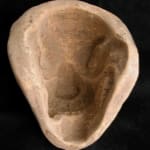Mayan Sculpture Mold, 300 CE - 900 CE
Terracotta
3.25 x 2.25
PF.6098
Further images
This work of art, an ancient sculptor’s mold, grants us a unique insight into the creative process of Mayan artists. Such a mold would have been used in the fabrication...
This work of art, an ancient sculptor’s mold, grants us a unique insight into the creative process of Mayan artists. Such a mold would have been used in the fabrication of small terracotta sculptures. Pressed into the wet clay, the intricately carved pattern of the mold would be replicated. The highly detailed pattern of the interior belies the soft curves of the abstract exterior. This particular mold replicates the face of an animal, most likely a canine, but perhaps a serpent. The most prominent feature of the face is the elongated jaw, specifically the large, sharp fangs visible in the open mouth. Also prominent is the nose, which suggests this animal’s canine attribution. This face would have presumably been attached to a larger body while still wet. It is possible that a generic body was used for several different faces; it is also possible that a specific body was intended to be joined with this face only. This little mold, as functional as it is, was once used to create images of gods. That sacred idols worthy of worship could be created from this mold implies that the mold itself has some inherent power. Clearly, in the hands of a master sculptor, this mold has the power to embody the gods. Today, this mold is a relic of ancient artistry, transplanted from an ancient Mayan workshop into our hands, linking us directly with the creative process of long forgotten sculptors.





